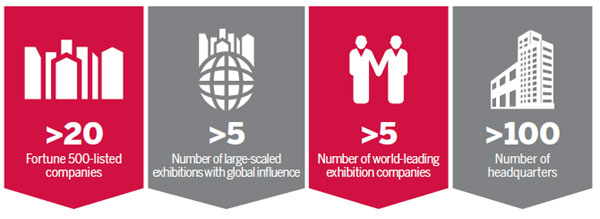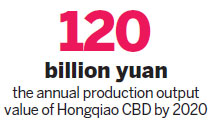Pillar for delta's integration

The Shanghai Hongqiao central business district will focus on three key development areas big transportation, big exhibitions and big business as it continues to upgrade itself as part of its 13th Five-Year Plan (2016-20).
In addition to these three key areas, the CBD will also be focus on "four services" and "five features" to support the zone's development.
The former refers to the role the CBD will play in the Yangtze River Economic Belt, the development of the city cluster plan for the Yangtze River Delta.
The latter refers to the five developmental aspects that the CBD will focus on: smart carbon development, low carbon development, modern business innovation development, industry development and city integration development.
According to the CBD's 13th Five-Year Plan, the Hongqiao Transportation Hub, which contains Hongqiao Airport and Hongqiao High-speed Railway Station, will be developed into a first-class traffic hub that can serve people's various transportation demands including transfers and inner-city commuting. The hub will be capable of transporting more than 400 million passengers annually by the end of 2020.
In order to achieve this goal, Hongqiao CBD plans to further upgrade its traffic network and focus its attention on the enhancement of traffic services. Efforts will include upgrading road networks to better connect the CBD with other parts of Shanghai and the expansion of the metro service network to encourage more people to use public transport.
"A well-established traffic network is the standard configuration of many world-leading business districts. For instance, Manhattan is known for its chessboard-shape traffic network, which ensures that people can find a metro station within 1 kilometer," said Min Shilin, executive deputy director of the Shanghai Hongqiao CBD Administrative Committee.
"Hongqiao CBD is positioned to be a world-class gathering place for businesses and we will strive to enhance our transportation network to such a level," Min said.

According to a draft master plan released by the Shanghai government in August, Hongqiao CBD will establish a metro service network where station entrances are located within 600 meters of one another. About 45 percent of the CBD will be covered by this network.
On the exhibition front, the plan states that the CBD will play a crucial role in Shanghai's bid to become an "international exhibition city".
Min also said that the National Exhibition and Convention Center (Shanghai) (NECC) in the CBD will be taking measures to ensure that the local exhibition industry achieves sustainable growth similar to its counterpart in Hanover, Germany.
The total exhibition area in the NECC is expected to reach 7 million square meters by 2020. About 67 percent of the exhibitions in the NECC will be held in exhibition areas measuring 100,000 sq m. The CBD also plans to host at least five major exhibitions and at least 30 small and medium-sized ones over the next five years.
Furthermore, the CBD will accelerate the process of developing exhibition-related industries such as warehouse and logistic services and more policies will be introduced to support a high caliber, meeting-focused exhibition industry as well as the development of an exhibition-related professional service industry.
For "big business", Hongqiao CBD will focus on developing commerce, trading and exhibition functions in the next five years.
Hongqiao CBD will be a platform for a headquarters economy, meeting and exhibition businesses, bonded trading businesses, tourism and retailing, aviation, culture and media businesses and technology innovation, according to the 13th Five-Year Plan.
The annual production output value of the CBD is expected to reach 120 billion yuan ($18.03 billion) by the end of 2020. The zone is expected to host more than 20 Fortune 500-listed companies and more than 100 headquarters by 2020.
(China Daily 09/05/2016 page40)














